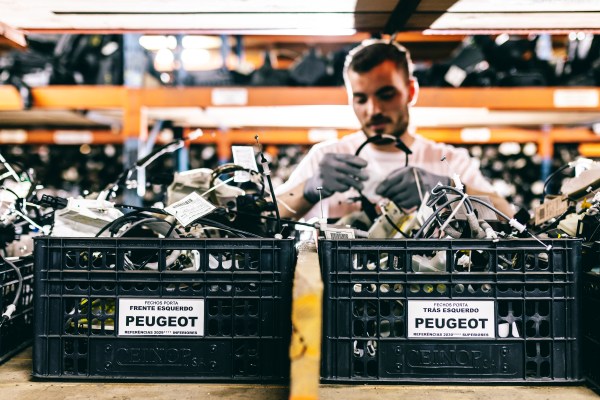Stellantis on Tuesday launched a plan for its business unit dedicated to circular economics, which, to cut through the jargon, is a segment of the company dedicated to sustainability and recycling.
The parent company to brands like Jeep, Dodge, Maserati and Peugeot estimates that the new unit will bring in more than €2 billion in revenue by 2030 and drive the company’s carbon net-zero target by 2038.
The move comes nearly five months after Stellantis pleaded guilty to concealing the amount of pollution created by its diesel engines and agreed to pay $300 million to settle allegations of criminal fraud. Like other automakers that faced similar scandals, such as Volkswagen, Stellantis read the room and charged forward on a more environmentally acceptable path; one that aims to drive value for Stellantis stakeholders.
The new unit, which Stellantis first announced in March as part of its Dare Forward 2030 strategic plan, will focus on designing for a circular economy and relying on the tried and tested 4R strategy — remanufacture, repair, reuse, recycle.
Let’s break down exactly what that will look like for Stellantis.
Designing for a circular economy
“In some regards, the circular economy actually starts at the point of design where, for any product or service, how do I design it so that it lasts as long as possible, either through durability of materials or refreshing?” Alison Jones, senior vice president of Stellantis’ global circular economy unit, said during a press briefing Tuesday.
In a circular economy, parts’ deaths are anticipated, meaning they’re designed to be broken down for recycling. Products are sketched out to be built with recycled materials, Jones said.
Jones pointed to the design of the electric 2020 Fiat 500 e, the seats of which were partly made from Seaqual Yarn, which is made from recycled plastic (10% comes from the oceans and 90% comes from land.)
The executive also noted the design of the Citroën Oli concept car, which is targeting a “best-in-class” life cycle assessment (LCA) by reducing the weight and complexity of the vehicle and using durable recycled and recyclable materials. (An LCA is a method that automakers use to calculate the environmental impact of a vehicle’s entire life cycle from procurement of raw materials and manufacturing to the use, recycling and disposal of parts. Automakers usually perform their own LCAs, and there is no industry standard yet.)
Stellantis said it will work to extend the useful life of vehicles through repairing, reconditioning and using remanufactured and reused parts. When the car reaches the end of its life, Stellantis will work to recycle as many materials as possible back into the manufacturing loop, according to Jones.
Remanufacture, repair, reuse, recycle
“Because when we remanufacture or repair parts, we save up to 80% of the raw material and up to 50% of the energy consumption needed to produce the equivalent new part,” Jones said.
Stellantis sees most of the revenue for the circular economy business unit coming from remanufacturing. Per 2021’s Corporate Social Responsibility report, Stellantis brought in €528 million in revenue from remanufactured parts, “repair and return” services in Europe and selling reused parts.
Jones said Stellantis is on track to deliver 31% year-over-year growth in revenue from remanufacturing. By 2030, the company aims to bring in 4x revenue through extending the life of vehicles and 10x in recycling revenue. Much of this will be facilitated through the automaker’s e-commerce platform that connects buyers and sellers in 155 countries and houses more than 4.5 million parts for sale, Jones said.
The company said that it has over 12,000 remanufactured parts across 40 production lines that can be resold in its global remanufacturing facilities. Stellantis has more than 1,000 parts that can be repaired, as well as 21 battery e-repair centers. Jones said it recycled 1 million parts in the first half of this year.
Parts and accessories that have been remanufactured, reused or recycled will have a new label on them, SUSTAINera, to indicate the savings of materials and energy compared to equivalent new parts.
Building a global ecosystem
“We want to increase our capability, increase our teams and our facilities,” Jones said. “And we’re going to add more product lines, we’re going to add more countries and we’re going to add more activities to be able to achieve on our ambition, because we believe we’ve got an ecosystem that we can develop that is smart and integrated.”
Stellantis said that its European circular economy hub will open in 2023 at the Mirafiori Complex in Italy. The hub will initially focus on vehicle reconditioning, vehicle dismantling and parts remanufacturing.
Additionally, Stellantis will prioritize building out “local loops,” or facilities within different countries or states that can provide some or all of the four Rs, which will allow for greater speed of delivery for customers as well as reduced logistics across regions and countries. For example, in Brazil, key parts like starter motors and alternators from Stellantis brand vehicles are remanufactured, distributed and sold across 1,000 local dealerships, the company said.
Over the next eight years, Stellantis will work on either beefing out its own capabilities to remanufacture, reuse, repair and recycle, or it will work with relevant partners. For instance, Stellantis has partners in the U.S. to remanufacture parts, but it will handle in-house repairs at its Detroit plant, as well as collect secondary raw materials through its Memphis call center, according to Jones. The executive also noted that Stellantis has a network of partners available to help with battery refurbishment, repair and recycling.
“We have strong partners, and we do some in-house and that’s how we’ll move forward,” Jones said. “Looking to balance if there’s a specialist skill set that’s better employed through a supplier, or actually, if there’s colleagues we can retrain, we would look to do that within Stellantis. And we do that on a case-by-case basis.”
